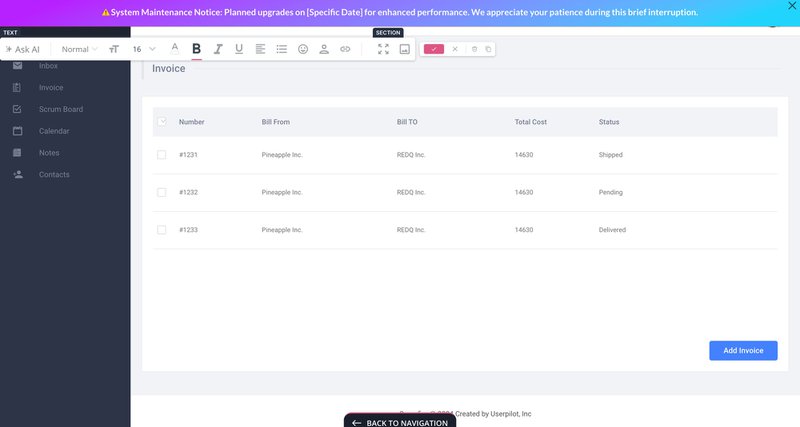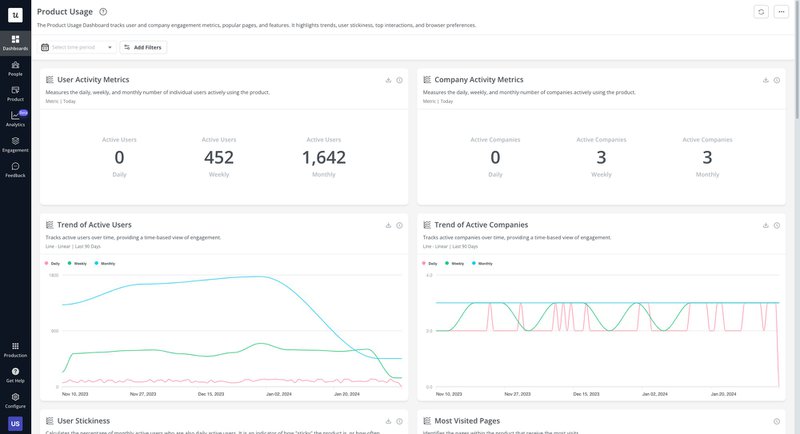
You may have heard a horror story about a business not using impact analysis. It could be launching features that are half-finished and causing customer problems with THEIR customer. It could be push changes that bring your entire product down. Whatever it is, it’s not good. This could be avoided with the use of impact analysis.
Try Userpilot Now
See Why 1,000+ Teams Choose Userpilot

What is impact analysis?
Impact analysis is a process to understand the potential consequences of changes in a project, system, or process before making decisions. It helps you evaluate the effects these changes could have, allowing you to prepare or adjust accordingly.
Why is it important to conduct an impact analysis?
Conducting an impact analysis is crucial for the smooth operation and success of any organizational project or change. Here’s why it’s so important:
- Identify Potential Risks and Challenges: By analyzing potential risks and challenges early on with tools like user behavior tracking, you can develop strategies to mitigate these risks. This proactive approach helps minimize disruptions and ensures your project stays on track.
- Understand Resource Requirements and Allocate Resources Effectively: Impact analysis gives you a clear picture of the resources you’ll need, including time, money, and manpower. Use this insight to allocate resources effectively, ensuring efficient and well-supported project management.
- Anticipate and Address Potential Impacts on Customers: Consider how changes, especially those stemming from a disruptive event, affect your customers. This approach allows you to take measures to maintain or improve customer satisfaction. This might involve adjusting your approach to ensure customer needs are met and their experience with your service or product remains positive, even in the face of unexpected challenges.
Types of business impact analysis
Business impact analysis comes in various forms, each tailored to understand the different dimensions of potential impacts within an organization. Here’s a look at some key types:
- Traceability Impact Analysis: This approach traces connections across a project or system, showing how changes in one area can affect others for a comprehensive understanding. It’s beneficial for complex projects with interconnected elements.
- Dependency Impact Analysis: Dependency impact analysis assesses how changes affect interconnected elements within a project or system, highlighting critical components at risk. It enables planning for cascading effects, ensuring awareness and preparedness for changes across dependencies.
- Experimental Impact Analysis: This method experiments with or simulates changes in a controlled setting to observe potential impacts, predicting outcomes before real-world implementation. It offers insights into proposed modifications, especially for testing new ideas or complex system changes.
Types of impact assessment methods
Impact assessment methods vary in approach and focus, offering different lenses to evaluate the effects of changes within projects or organizations. Here’s a closer look at some common methods:
- Organizational Approach: This method evaluates the impact of changes across the entire organization, considering factors such as culture, processes, and structure. It aims to understand how changes align with organizational goals and values, ensuring that they contribute positively to the overall direction and health of the company.
- McKinsey 7Ss Approach: The McKinsey 7Ss approach breaks down the analysis into seven key components: strategy, structure, systems, shared values, skills, style, and staff. Examining the impact of changes on each of these areas provides a thorough understanding of how adjustments might affect the organization’s ability to achieve its objectives. This method is particularly useful for ensuring that all aspects of the organization are considered and aligned.
- Tools-Based Approach: This method involves using specific tools and software to analyze the impact of changes. These tools can range from simple spreadsheets to sophisticated software applications designed to model and predict outcomes based on various scenarios. The tools-based approach is helpful for quantifying impacts and providing data-driven insights into the potential effects of changes.
How to conduct an impact analysis?
Conducting an impact analysis involves a systematic approach to evaluating the potential effects of changes, ensuring that decisions are informed and strategic.
Identify the scope of change
To kick off your impact analysis, start by pinpointing the exact nature of the change. Is it a tweak in your processes, an update to a product, the rollout of a new feature, or perhaps a significant shift within your organization? Once you’ve identified what’s changing, it’s crucial to outline the boundaries of this change. This means determining what will change and where and to whom these changes will apply.
Brainstorm potential impacts of change
Involve key stakeholders in a collaborative brainstorming session using tools like Miro. This facilitates the identification of various impacts the change might have, ensuring comprehensive and inclusive planning.

Gather information on affected business processes and resource
Conduct a thorough analysis of the business processes and resources that might be affected by the proposed change.
For instance, scheduling system maintenance requires an understanding of user activity patterns. With Userpilot’s trend reports, you can get a bird’s-eye view of user activity across different periods.
By selecting a time with the least user activity, the impact on workflows can be minimized, thus ensuring a smoother transition.

Develop recovery strategies to reduce negative impacts
Considering the inevitability of challenges, it is imperative to develop business recovery strategies.
Contingency plans, resource allocation, and communication strategies play a pivotal role in helping you mitigate any possible negative impact.
For instance, implementing system maintenance can be accompanied by in-app banners, effectively communicating changes to users and reducing potential disruptions.

Implement the changes and recovery strategies
Once strategies are in place, the implementation phase begins.
For example, when you roll out the new UI for the product dashboard, you can accompany it with comprehensive guidance to ease user onboarding with the new interface.
These mitigation strategies minimize friction and enhance the user experience by providing clear instructions and support throughout the transition.

Report and analyze the results
Monitor the impact of changes by tracking key metrics like product usage, support ticket volumes, and in-app feedback.
This analysis helps understand the effectiveness of the implemented changes and guides future improvements, ensuring continuous enhancement of user experience and operational efficiency.

Iterate results and make recommendations
Analyze collected data to pinpoint areas needing improvement or adjustment. Refine strategies based on these insights and make recommendations for enhancing the process’s impact. This iterative approach ensures continuous optimization and alignment with organizational goals.
Conclusion
You should never leave changes in your product, large or small, without considering the impact, especially if you’re updating your critical business processes. Your customer won’t appreciate trying to use your product, and your normal business operations aren’t running. Impact analysis is the key to preventing negative consequences on your business environment and keeping your customers happy.
Do you need help with performing impact analysis? Get a Userpilot Demo and see how you can easily view your user’s trends, display in-app banners, and monitor key metrics like product usage, support ticket volumes, and in-app feedback.







